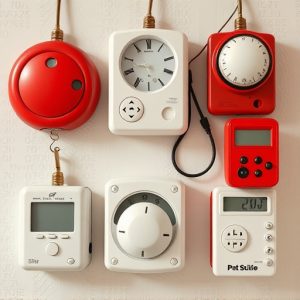Personal Alarms with Alarm Function: Range, Benefits & Choosing Tips
Personal alarms with high-decibel sounds (up to 120 dB) act as powerful deterrents against threats,…….
Personal alarms with high-decibel sounds (up to 120 dB) act as powerful deterrents against threats, attracting attention within several hundred feet. Their effectiveness varies based on ambient noise, terrain, and weather conditions. Advanced features like automatic fall detection, GPS tracking, and emergency contacts enhance safety in diverse environments. For optimal use, understand the alarm's range (up to 500 meters outdoors, reduced in urban areas), choose a compact design suitable for portability, and select models with high decibel ratings for maximum auditory impact to ensure personal security.
Personal safety is paramount, and personal alarms with alarm functions offer a powerful tool for protection. This comprehensive guide explores the significance of these devices in enhancing individual security. From understanding the basics to delving into specific types, features, and range, we uncover why personal alarms are essential. Learn about their benefits, from deterring potential threats to alerting others nearby. Discover key factors to consider when choosing the right alarm for your needs, ensuring you’re prepared and informed in today’s world.
- Understanding Personal Safety Tools: The Role of Alarms
- Types of Personal Alarms and Their Unique Features
- How Far Can a Personal Alarm Sound? Decoding the Range
- Benefits of Using Personal Alarms with Alarm Functions
- Choosing the Right Personal Alarm: Factors to Consider
Understanding Personal Safety Tools: The Role of Alarms
Personal safety tools equipped with alarm functions play a pivotal role in enhancing individual security and deterring potential threats. These devices serve as powerful deterrents, leveraging loud and distinct alarm sounds to attract attention and alert others in distress. Understanding the range and effectiveness of personal alarms is crucial. Modern personal alarms can emit sounds up to 120 decibels, which is approximately the same volume as a loud power tool or a heavy truck engine.
The distance at which these alarms can be heard varies based on factors like ambient noise, terrain, and weather conditions. However, they are designed to signal for help quickly and effectively within a range of several hundred feet, ensuring that users have a critical window to escape dangerous situations or attract assistance. Moreover, many personal safety tools with alarm functions incorporate advanced features like automatic fall detection, GPS tracking, and emergency contact options, providing comprehensive protection in various environments.
Types of Personal Alarms and Their Unique Features
Personal alarms are compact, powerful tools designed to attract attention and deter potential threats, often with a loud sound that can reach up to 120 decibels – equivalent to a power tool or fire alarm. These devices come in various types, each with unique features catering to different needs and preferences.
One common type is the hand-held personal alarm, typically activated by a button press. It projects a high-intensity sound, often with flashing lights, to startle and disorient an assailant. Some models offer additional features like long-lasting batteries, water resistance, or even GPS tracking for enhanced safety. Another variety is the body-worn alarm, designed to be clipped onto clothing or attached to a belt. These devices are discreet but still pack a punch when activated, making them ideal for travel or outdoor activities. Advanced models may include stun features or automatic emergency alerts sent to pre-selected contacts.
How Far Can a Personal Alarm Sound? Decoding the Range
Personal alarms are designed to draw attention and deter potential threats, making them valuable tools for personal safety. But how far can these alarm sounds actually reach? The range of a personal alarm varies significantly depending on several factors. Outdoor environments with minimal obstructions like buildings or trees can allow alerts to travel further, sometimes up to 500 meters (1640 feet) or more. However, in urban settings or areas with many tall buildings and other structures, the effective range drops dramatically.
The loudness of a personal alarm is measured in decibels (dB). Many high-decibel alarms can produce sounds around 120 dB, which is about as loud as a power tool or a jet taking off. While this volume ensures that the sound carries well over short distances, it’s the open space and line of sight that truly maximize the range. In enclosed spaces or noisy environments, the alarm’s effectiveness diminishes quickly, emphasizing the importance of using these tools in appropriate contexts for optimal personal safety.
Benefits of Using Personal Alarms with Alarm Functions
Personal alarms with alarm functions offer a range of benefits for personal safety, especially in unexpected or dangerous situations. One of the key advantages is their ability to attract attention and deter potential threats quickly. These alarms often emit loud and distinct sounds that can travel up to 100 feet or more, ensuring that help is summoned promptly. The high decibel levels are designed to startle and alert bystanders, drawing immediate attention to the user’s location, which can be crucial in emergency scenarios.
Additionally, these devices provide peace of mind, empowering individuals to take control of their safety. Their portability allows users to carry them readily, ensuring they’re always prepared. Whether for personal protection while walking alone or as a deterrent during outdoor activities, these alarms offer a simple yet effective way to ward off potential harm. The ability to set off a loud alarm with the push of a button is a powerful tool that can make all the difference in an unsettling situation, making it an essential addition to one’s personal safety kit.
Choosing the Right Personal Alarm: Factors to Consider
When selecting a personal alarm with an alarm function, understanding how far it can sound is a crucial consideration. The range of audible notification varies among models, from 60 to 120 decibels (dB). Higher dB ratings indicate louder sounds, ensuring your alert reaches nearby ears effectively. This feature is particularly vital in potentially dangerous situations, as a loud alarm can startle assailants and attract attention, providing crucial time for escape or assistance.
Other factors include portability and ease of use. Smaller, lightweight alarms are easier to carry and deploy quickly. Additionally, consider the type of alarm mechanism, such as piezoelectric or electronic, each with distinct sound patterns. Piezoelectric alarms tend to produce consistent, high-pitched sounds, while electronic ones offer customizable alerts. Durability and water resistance are also essential, especially for outdoor activities or unpredictable weather conditions.
Personal safety tools equipped with alarm functions offer a powerful means of deterring potential threats and ensuring your well-being. Understanding the range at which these alarms can sound, from 80 to 120 decibels, is crucial for maximizing their effectiveness. This article has explored various types of personal alarms, their unique features, benefits, and essential factors to consider when choosing the right one for your needs. By equipping yourself with such tools, you gain peace of mind and an extra layer of protection in unexpected situations.


